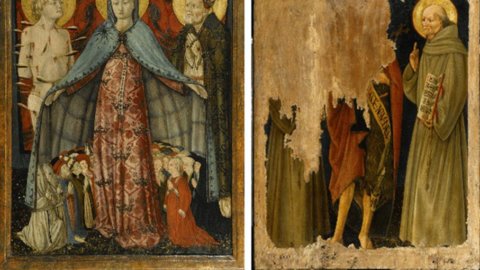From the December 11, 2015 to November 20, 2016, for the entire duration of the extraordinary Jubilee of Mercy, wanted by Pope Francis, the Diocesan Museum hosts the Madonna della Misericordia by Antonio da Fabriano.
The image of the Virgin, owned by the Toniolo Institute of Milan, is a painting, an oil and tempera on wood, created by a master from the Marches around 1470, and has recently been the subject of a careful intervention carried out by the Carlotta restoration studio Beccaria & Co.
“The Diocesan Museum – says its director, Paolo Biscottini, who has developed a relationship with the City over time – wishes to offer during the Jubilee the opportunity to meditate on the meaning and intention of Pope Francis. He does it with a wonderful XNUMXth century table, generously granted by the Toniolo Institute, which allows us to recover the iconographic meaning of the Madonna della Misericordia. The image invites us to gather under Mary's great mantle, to enter her sacred space. There a new story can begin for each of us and also for the Museum, which is ideally placed in this place.
The work fits perfectly into a typology of processional banners painted on both sides, which is widespread in the fifteenth century in the Marche region. On the recto, the Madonna della Misericordia appears who gathers a crowd of faithful under her mantle, representing the community enjoying the table. To her right stand out in the foreground, emerging from the numerous colored hats, a bishop, who peeks out from behind the shaft of the Virgin, a cardinal and a pope, followed by a middle-aged gentleman and two members of a brotherhood, dressed white and hooded. The layman is mirrored, on the other side, by a younger woman, probably his wife, who is detached from the group of other devotees and wears a beautiful red dress with open and hanging sleeves, consistent with fashion trends after mid of the fifteenth century.
On the sides of the Virgin are San Sebastiano, pierced by fourteen arrows, and a holy bishop, not identified by specific attributes.
Of the reverse, until recent times, only the image of San Bernardino da Siena was known – to the right of the viewer – and a fragment of the figure of San Giovanni Battista, while the left half of the painting had been covered to conceal the losses of the original painting.
On both sides of the painting the figures stand out on this side of a blue background, an alternative to gold and perhaps chosen for economy reasons; unique case in Antonio da Fabriano, but visible in at least one other Franciscan banner of the Fabriano area. Only on the recto is a decorated fabric hooked to the edges of the backdrop thanks to four rings, similar to the cloth of honor that in the figures of the seated Virgin covers the throne.
For the occasion, a catalog has been published, edited by Scalpendi Editore, edited by Paolo Biscottini.
Biographical notes
Anthony of Fabriano, documented from 1447 to 1489 prevalent in his hometown, was among the protagonists of early Renaissance painting in the Marches. Fundamental to his artistic career was the experience gained in Genoa, where it is documented in 1447-48, an environment in which he came into contact with the Flemish painting widespread in that territory. Shortly after returning to Fabriano, he executed his masterpiece in 1451, the panel with San Girolamo in the studio of the Walters Art Museum in Baltimore, profoundly influenced by the painting of Jan van Eyck. He then came into contact with other exponents of the Marche Renaissance, the Urbino between Carnival, the Camerino Giovan Angelo di Antonio and Giovanni Boccati; and perhaps he had the possibility, perhaps through these artists, of getting to know the art of Piero della Francesca. Among his works are the triptych of the parish church of Genga (1474), the altarpiece of the Museum of Fine Arts in Budapest, the frescoes of the convent of San Domenico in Fabriano (about 1480). Antonio da Fabriano's painting, full of luministic truths, imbued with glossy reflections and brilliant colors, ranks among the most captivating items of the fifteenth century, for the original synthesis of various figurative motives: from the legacy of Gentile da Fabriano to Flemish painting, from the reflections of the Tuscan Renaissance to the intense expressive vein of the masters of his region.





